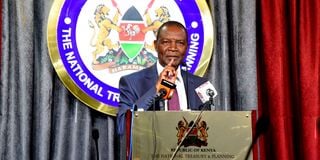State outlines bold step to curb massive borrowing

National Treasury and Economic Planning Cabinet Secretary Prof Njuguna Ndung'u. In the draft Budget Policy Statement (BPS) 2023, the National Treasury proposes to borrow Sh695 billion in the financial year 2023/24, down from the Sh849 billion the government is expected to borrow in the financial year ending June.
President William Ruto has taken the first bold step to slow down on borrowing, with a Sh154 billion reduction on the amount expected to be borrowed during his first budget in office.
In the draft Budget Policy Statement (BPS) 2023, the National Treasury proposes to borrow Sh695 billion in the financial year 2023/24, down from the Sh849 billion the government is expected to borrow in the financial year ending June.
This could reduce the pace of accumulation of Kenya’s public debt which has risen by an average Sh1 trillion over the past three years, raising from Sh6.69 trillion in June 2020, Sh7.69 trillion in June 2021 and Sh8.59 trillion by June last year.
Reduce deficit
Treasury in the draft BPS says it plans to reduce the budget deficit — the negative balance on total government revenues and expenditures during a financial year — from 5.8 per cent of the Gross Domestic Product (GDP) in 2022/23 to 4.3 per cent of GDP in 2023/24. The government’s need to borrow arises when its planned expenditures exceed revenues, thus necessitating credit to fill the financing gap.
Treasury said the 2023/24 fiscal deficit will be financed through Sh198.6 billion (equivalent to 1.2 per cent of GDP) of external borrowing, and borrowing of Sh496.6 billion (equivalent to three per cent of GDP) from the domestic market.
Treasury projects to lower the level of public debt as a share of GDP from 65.7 per cent by October 2022, to 51 per cent by 2026.
It noted that, while Kenya’s debt remains sustainable, it faces a high risk of debt distress according to the International Monetary Fund, with the Present Value of external debt-to-export and Public and Publicly Guaranteed debt-service-to-exports indicators above the thresholds.
Borrowing spree
Since assuming office, President Ruto been outspoken against the government’s borrowing spree that has accumulated a huge burden for taxpayers, vowing to only borrow to fund development activities, while growing local revenues to minimise the need to borrow.
Treasury last year projected that debt service would cross Sh1 trillion mark during this financial year, highlighting the growing burden the current Sh8.7 trillion debt continues to have on taxpayers, with nearly half of the debt being external, thus vulnerable to worsening foreign exchange trends.
The government projects to lower expenditure as a share of GDP from 23.3 per cent this financial year to 22.4 per cent in 2023/24. In nominal terms, however, spending will grow from Sh3.39 trillion to Sh3.64 trillion.
“The expenditures comprise of recurrent of Sh2,422.3 billion (14.9 per cent of GDP) and development of Sh796.4 billion (4.9 per cent of GDP),” Treasury stated.





